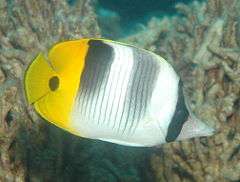Pacific double-saddle butterflyfish
The Pacific Double-saddle Butterflyfish or False Furcula Butterflyfish (Chaetodon ulietensis), is a species of butterflyfish (family Chaetodontidae). It flourishes in coral-rich environments in the central Indo-Pacific region. Their range extends from the Cocos-Keeling Islands to the Tuamotu Islands, and north to Japan. They are usually found from the surface to 20 m depths, and like shallow channels with high current.[2]
| Pacific Double-saddle Butterflyfish | |
|---|---|
 | |
| Scientific classification | |
| Kingdom: | |
| Phylum: | |
| Class: | |
| Order: | |
| Family: | |
| Genus: | Chaetodon (but see text) |
| Subgenus: | Rabdophorus |
| Species: | C. ulietensis |
| Binomial name | |
| Chaetodon ulietensis G. Cuvier, 1831 | |
Description and systematics
These fish can reach a size of 15 cm (5.9 in).[3] They are white with vertical thin black lines down the body and two dark saddles on the fore and hind back, which softly grade into the background color bellywards gradient. Immediately after the hind quarter saddle, the body and tail is bright yellow with a black spot on the caudal peduncle. The dorsal fin has a streak of yellow from the crown of the head to the tail. Like most of its relatives this species displays a black eye band like a mask. As in most butterflyfish, the Pacific double-saddle butterflyfish is prone to blanching at night and when startled.[2]
It belongs to the large subgenus Rabdophorus which might warrant recognition as a distinct genus. In this group, the closest relative of this peculiar species is the similar-looking Black-wedged Butterflyfish, C. falcula. Other fairly close relatives are the quite differently-shaped but similarly-colored Lined (C. lineolatus) and Spot-naped butterflyfishes (C. oxycephalus), while the Blue-cheeked Butterflyfish (C. semilarvatus) seems to be a far more basal lineage relative to all of these. The vertical lines are present in all of these, while a white body with yellow behind and black on back and caudal peduncle are only shared among the four less ancient species.[4]
Ecology
C. ulietensis is often found singly or in pairs on coral-rich reef systems, foraging on sessile invertebrates and algae. It is not a territorial species that freely grazes throughout a wide range within reefs, lagoons and harbors, and every now and then large groups congregate at rich feeding spots. It is rarely ever observed in a deep reef environment or the open sea; juveniles are typically reared in shallow lagoons, estuaries or harbors.[2]
An opportunistic omnivore, diet consists mainly of microscopic algae, other plankton, and small sessile invertebrates. As a measure of defense, they typically wedge themselves in tight crevasses to escape predators.[2]
In the aquarium
Although common in the wild, it is rarely imported by the aquarium trade. In aquarist terms, it is considered a hardy Chaetodon and beneficial for the control of nuisance pests. The Pacific Double-saddle Butterflyfish has been observed as a beneficial predator of Aiptasia and Majano sea anemones. Like most Raccoon Butterflyfish (C. lunula), C. ulietensis will eliminate this nuisance within a 2- to 6-week period depending on the anemone population and size of the tank. And unlike most raccoon butterflyfish, this species rarely feeds on ornamental corals. The Pacific Double-saddle Butterflyfish readily accepts most prepared frozen and dry foods, thus it can easily make the transition to aquarium life, unlike the Copperband Butterflyfish (Chelmon rostratus) or other less hardy Chaetodon species.
Footnotes
- Myers, R. & Pratchett, M. 2010. Chaetodon ulietensis. In: IUCN 2013. IUCN Red List of Threatened Species. Version 2013.1. www.iucnredlist.org. Downloaded on 10 September 2013.
- FishBase (2008)
- Dianne J. Bray (2011). "Doublesaddle Butterflyfish, Chaetodon ulietensis Cuvier 1831". Fishes of Australia. Archived from the original on 2019-04-22. Retrieved 2020-04-04.
- Fessler & Westneat (2007), Hsu et al. (2007)
References
| Wikimedia Commons has media related to Chaetodon ulietensis. |
- Fessler, Jennifer L. & Westneat, Mark W. (2007): Molecular phylogenetics of the butterflyfishes (Chaetodontidae): Taxonomy and biogeography of a global coral reef fish family. Mol. Phylogenet. Evol. 45(1): 50–68. doi:10.1016/j.ympev.2007.05.018 (HTML abstract)
- FishBase (2008): Chaetodon ulietensis. Version of 2008-JUL-24. Retrieved 2008-SEP-01.
- Hsu, Kui-Ching; Chen, Jeng-Ping & Shao, Kwang-Tsao (2007): Molecular phylogeny of Chaetodon (Teleostei: Chaetodontidae) in the Indo-West Pacific: evolution in geminate species pairs and species groups. Raffles Bulletin of Zoology Supplement 14: 77-86. PDF fulltext
External links
- Advanced Aquarist Magazine
- Australian Museum Online
- Wet Web Media - The Conscientious Marine Aquarist
- Photos of Pacific double-saddle butterflyfish on Sealife Collection
